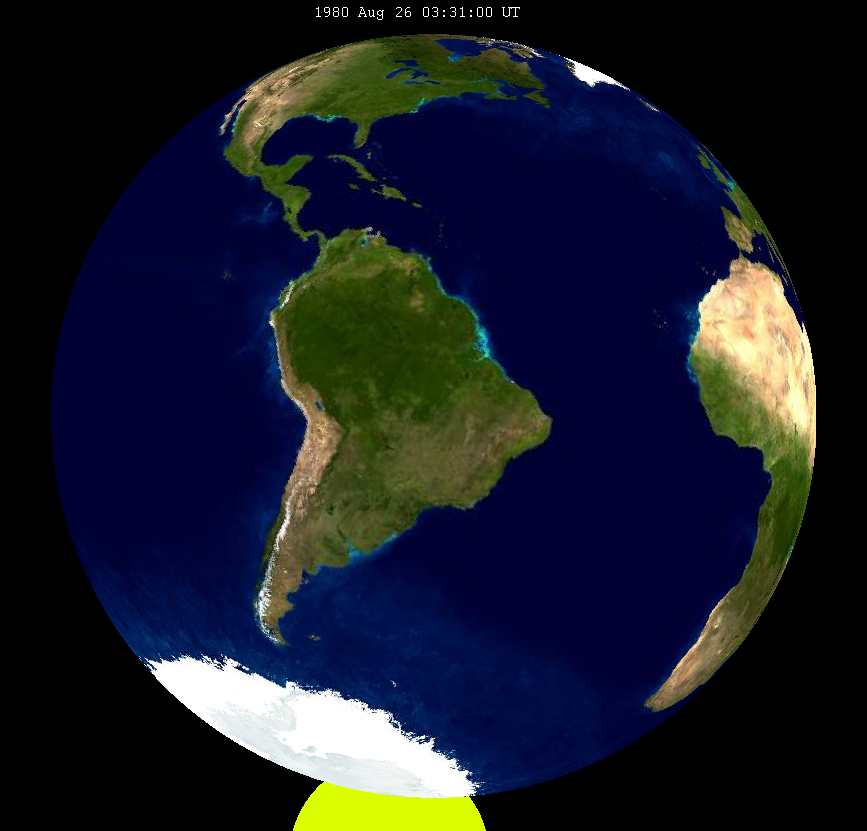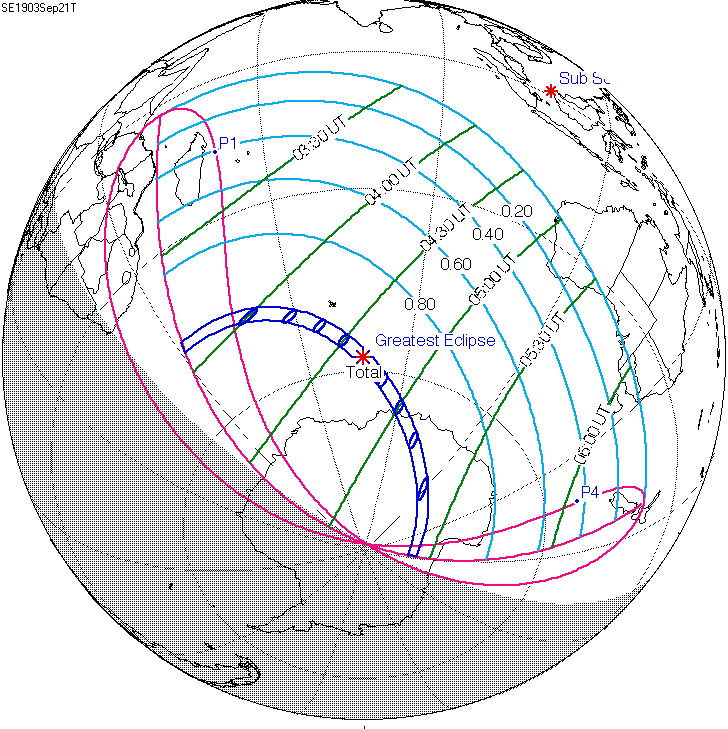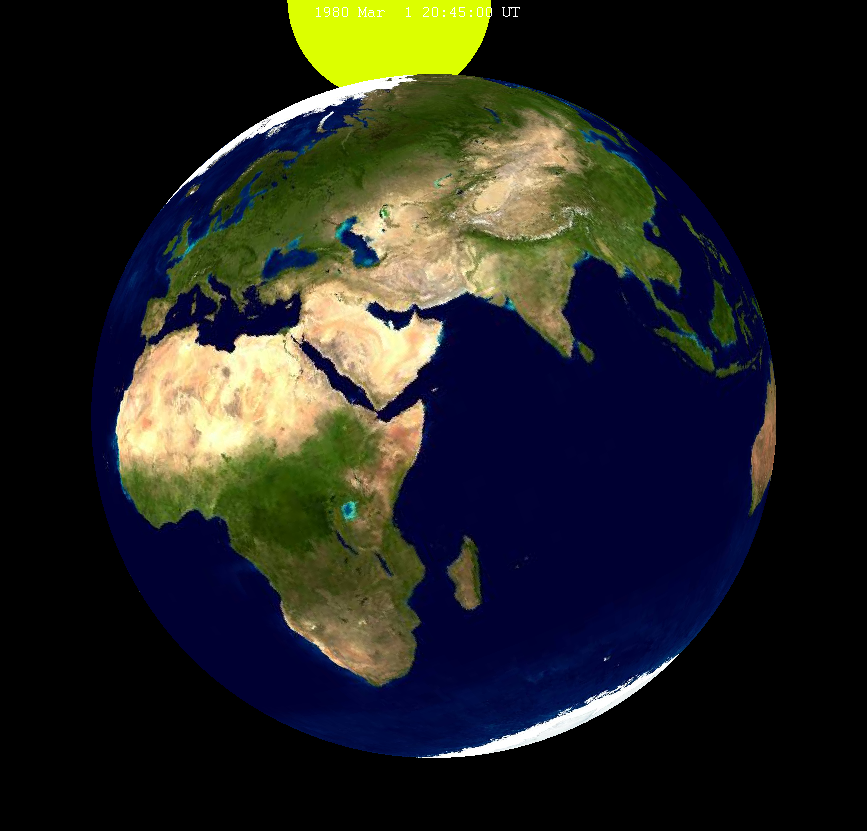|
August 1980 Lunar Eclipse
A penumbral lunar eclipse took place at the Moon's descending node of the orbit on Tuesday, August 26, 1980, the last of three penumbral lunar eclipses in 1980 with a penumbral magnitude of 0.70891. This subtle penumbral eclipse may have been visible to a skilled observer at maximum eclipse. 70.891% of the Moon's disc was partially shaded by the Earth (none of it was in total shadow), which caused a gentle shadow gradient across its disc at maximum; the eclipse as a whole lasted 3 hours, 34 minutes and 26 seconds. Visibility Related lunar eclipses Eclipses in 1980 * A total solar eclipse on Saturday, 16 February 1980. * A penumbral lunar eclipse on Saturday, 1 March 1980. * A penumbral lunar eclipse on Sunday, 27 July 1980. * An annular solar eclipse on Sunday, 10 August 1980. * A penumbral lunar eclipse on Tuesday, 26 August 1980. Lunar year series Half-Saros cycle A lunar eclipse will be preceded and followed by solar eclipses by 9 years and 5.5 days (a half s ... [...More Info...] [...Related Items...] OR: [Wikipedia] [Google] [Baidu] |
Lunar Eclipse
A lunar eclipse occurs when the Moon moves into the Earth's shadow. Such alignment occurs during an eclipse season, approximately every six months, during the full moon phase, when the Moon's orbital plane is closest to the plane of the Earth's orbit. This can occur only when the Sun, Earth, and Moon are exactly or very closely aligned (in syzygy) with Earth between the other two, which can happen only on the night of a full moon when the Moon is near either lunar node. The type and length of a lunar eclipse depend on the Moon's proximity to the lunar node. When the moon is totally eclipsed by the Earth, it takes on a reddish color that is caused by the planet when it completely blocks direct sunlight from reaching the Moon surface, as only the light reflected from the lunar surface has been refracted by Earth's atmosphere. This light appears reddish due to the Rayleigh scattering of blue light, the same reason sunrise and sunsets are more orange than during the day. Un ... [...More Info...] [...Related Items...] OR: [Wikipedia] [Google] [Baidu] |
Lunar Eclipse From Moon-1980Aug26
Lunar most commonly means "of or relating to the Moon". Lunar may also refer to: Arts and entertainment * ''Lunar'' (series), a series of video games * "Lunar" (song), by David Guetta * "Lunar", a song by Priestess from the 2009 album ''Prior to the Fire'' * Lunars, a fictional race in the series ''The Lunar Chronicles'' by Marissa Meyer Other uses * Lunar Magic, Super Mario World level editor * Lunar Design, or LUNAR, a San Francisco-based design consultancy * Hasselblad Lunar, a digital camera * Lunar, a brandname of Ethinylestradiol/cyproterone acetate, a birth control pill * Lunar C (Jake Brook, born 1990), English rapper See also * * * Lunar calendar, based upon the monthly cycles of the Moon's phase ** Lunar day, in such calendars ** Lunar month, in such calendars * Moon (other) * Luna (other) Luna commonly refers to: * Earth's Moon, named "Luna" in Latin * Luna (goddess), the ancient Roman personification of the Moon Luna may also refer to: Places ... [...More Info...] [...Related Items...] OR: [Wikipedia] [Google] [Baidu] |
Solar Eclipse Of February 16, 1980
A total solar eclipse occurred at the Moon's descending node of the orbit on February 16, 1980. A solar eclipse occurs when the Moon passes between Earth and the Sun, thereby totally or partly obscuring the image of the Sun for a viewer on Earth. A total solar eclipse occurs when the Moon's apparent diameter is larger than the Sun's, blocking all direct sunlight, turning day into darkness. Totality occurs in a narrow path across Earth's surface, with the partial solar eclipse visible over a surrounding region thousands of kilometres wide. The path of totality crossed central Africa, southern India, and into China at sunset. The southern part of Mount Kilimanjaro Mount Kilimanjaro () is a dormant volcano in Tanzania. It has three volcanic cones: Kibo, Mawenzi, and Shira. It is the highest mountain in Africa and the highest free-standing mountain above sea level in the world: above sea level and ab ..., the highest mountain in Africa, also lies in the path of totality. Occu ... [...More Info...] [...Related Items...] OR: [Wikipedia] [Google] [Baidu] |
March 1980 Lunar Eclipse
A penumbral lunar eclipse took place on Saturday, March 1, 1980, the first of three penumbral lunar eclipses in 1980. This subtle penumbral eclipse may have been visible to a skilled observer at maximum eclipse. 65.455% of the Moon's disc was partially shaded by the Earth (none of it was in total shadow), which caused a gentle shadow gradient across its disc at maximum; the eclipse as a whole lasted 3 hours, 58 minutes and 33.3 seconds. Visibility The penumbral eclipse was visible in northeast in North America, east in South America, Europe, Africa, Asia and Australia, seen rising over the Americas and setting over Asia and Australia. Related lunar eclipses Eclipses in 1980 * A total solar eclipse on Saturday, 16 February 1980. * A penumbral lunar eclipse on Saturday, 1 March 1980. * A penumbral lunar eclipse on Sunday, 27 July 1980. * An annular solar eclipse on Sunday, 10 August 1980. * A penumbral lunar eclipse on Tuesday, 26 August 1980. Lunar year series Half- ... [...More Info...] [...Related Items...] OR: [Wikipedia] [Google] [Baidu] |
July 1980 Lunar Eclipse
A penumbral lunar eclipse took place on Sunday, July 27, 1980, the second of three penumbral lunar eclipses in 1980. This very subtle penumbral eclipse was essentially invisible to the naked eye; though it lasted 2 hours, 17 minutes and 36.3 seconds, just 25.354% of the Moon's disc was in partial shadow (with no part of it in complete shadow). The moon passed in the northern edge of the Earth's penumbral shadow, and was the 70th lunar eclipse of Saros cycle 109. The Moon's apparent diameter was 3.1 days before perigee (Perigee on Wednesday, July 30, 1980), the Moon's apparent diameter was 2.2% larger than average. Visibility It was completely visible over Europe, Africa, the Indian Ocean, Asia and Australia, seen rising over Europe and Africa and setting over Asia and Australia. Related lunar eclipses Eclipses in 1980 * A total solar eclipse on Saturday, 16 February 1980. * A penumbral lunar eclipse on Saturday, 1 March 1980. * A penumbral lunar eclipse on Sunday, 27 ... [...More Info...] [...Related Items...] OR: [Wikipedia] [Google] [Baidu] |
Solar Eclipse Of August 10, 1980
An annular solar eclipse occurred at the Moon's ascending node of the orbit on August 10, 1980, centred over the Pacific Ocean. A solar eclipse occurs when the Moon passes between Earth and the Sun, thereby totally or partly obscuring the image of the Sun for a viewer on Earth. An annular solar eclipse occurs when the Moon's apparent diameter is smaller than the Sun's, blocking most of the Sun's light and causing the Sun to look like an annulus (ring). An annular eclipse appears as a partial eclipse over a region of the Earth thousands of kilometres wide. Annularity was visible in Tabuaeran of Kiribati, Peru, Bolivia, northern Paraguay and Brazil Brazil ( pt, Brasil; ), officially the Federative Republic of Brazil (Portuguese: ), is the largest country in both South America and Latin America. At and with over 217 million people, Brazil is the world's fifth-largest country by area .... Occurring 5 days before apogee (Apogee on Friday, August 15, 1980), the Moon's apparent ... [...More Info...] [...Related Items...] OR: [Wikipedia] [Google] [Baidu] |
Saros (astronomy)
The saros () is a period of exactly 223 synodic months, approximately 6585.3211 days, or 18 years, 10, 11, or 12 days (depending on the number of leap years), and 8 hours, that can be used to predict eclipses of the Sun and Moon. One saros period after an eclipse, the Sun, Earth, and Moon return to approximately the same relative geometry, a near straight line, and a nearly identical eclipse will occur, in what is referred to as an eclipse cycle. A sar is one half of a saros. A series of eclipses that are separated by one saros is called a ''saros series''. It corresponds to: *6,585.321347 solar days *18.029 years *223 synodic months *241.999 draconic months *18.999 eclipse years (38 eclipse seasons) *238.992 anomalistic months The 19 eclipse years means that if there is a solar eclipse (or lunar eclipse), then after one saros a new moon will take place at the same node of the orbit of the Moon, and under these circumstances another eclipse can occur. History The earliest disco ... [...More Info...] [...Related Items...] OR: [Wikipedia] [Google] [Baidu] |
Solar Saros 154
Saros cycle series 154 for solar eclipse A solar eclipse occurs when the Moon passes between Earth and the Sun, thereby obscuring the view of the Sun from a small part of the Earth, totally or partially. Such an alignment occurs during an eclipse season, approximately every six mon ...s occurs at the Moon's descending node, repeating every 18 years, 11 days, containing 71 events, with 61 before 3000 AD. All eclipses in this series occurs at the Moon's descending node. Umbral eclipses Umbral eclipses (annular, total and hybrid) can be further classified as either: 1) Central (two limits), 2) Central (one limit) or 3) Non-Central (one limit). The statistical distribution of these classes in Saros series 154 appears in the following table. Events References * http://eclipse.gsfc.nasa.gov/SEsaros/SEsaros154.html External linksSaros cycle 154 - Information and visualization {{Solar eclipses Solar saros series ... [...More Info...] [...Related Items...] OR: [Wikipedia] [Google] [Baidu] |
Solar Eclipse Of August 20, 1971
A partial solar eclipse occurred on August 20–21, 1971. A solar eclipse occurs when the Moon passes between Earth and the Sun The Sun is the star at the center of the Solar System. It is a nearly perfect ball of hot plasma, heated to incandescence by nuclear fusion reactions in its core. The Sun radiates this energy mainly as light, ultraviolet, and infrared radi ..., thereby totally or partly obscuring the image of the Sun for a viewer on Earth. A partial solar eclipse occurs in the polar regions of the Earth when the center of the Moon's shadow misses the Earth. It was visible near sunrise on August 21 over parts of Australia. Related eclipses Solar eclipses of 1968–1971 References External links 1971 8 20 1971 in science 1971 8 20 August 1971 events {{solar-eclipse-stub ... [...More Info...] [...Related Items...] OR: [Wikipedia] [Google] [Baidu] |
Solar Eclipse Of August 31, 1989
A partial solar eclipse occurred on August 31, 1989. A solar eclipse occurs when the Moon passes between Earth and the Sun The Sun is the star at the center of the Solar System. It is a nearly perfect ball of hot plasma, heated to incandescence by nuclear fusion reactions in its core. The Sun radiates this energy mainly as light, ultraviolet, and infrared radi ..., thereby totally or partly obscuring the image of the Sun for a viewer on Earth. A partial solar eclipse occurs in the polar regions of the Earth when the center of the Moon's shadow misses the Earth. Related eclipses Eclipses of 1989 * A total lunar eclipse on February 20. * A partial solar eclipse on March 7. * A total lunar eclipse on August 17. * A partial solar eclipse on August 31. Solar eclipses of 1986–1989 Metonic series References External links 1989 8 31 1989 in science 1989 8 31 August 1989 events {{Solar-eclipse-stub ... [...More Info...] [...Related Items...] OR: [Wikipedia] [Google] [Baidu] |







